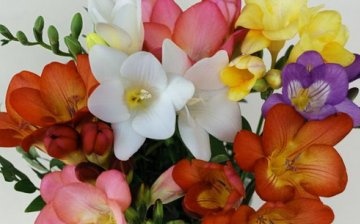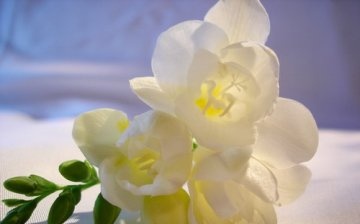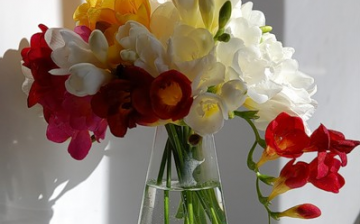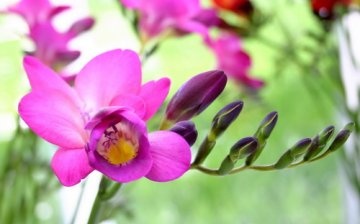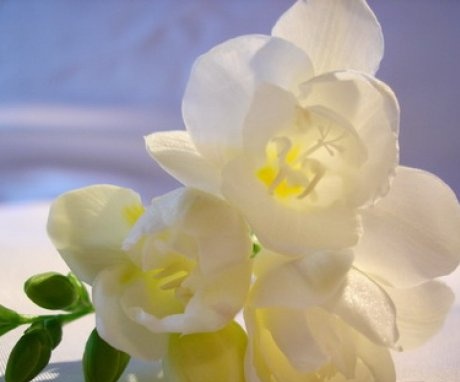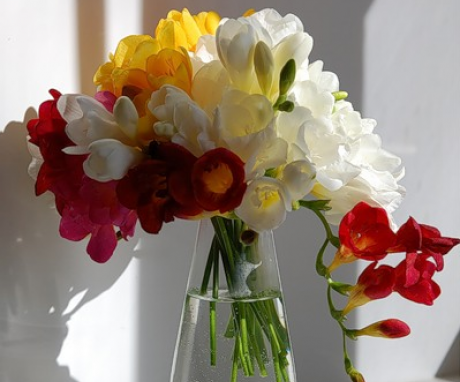Planting and caring for freesia
Freesia is a perennial African bulbous plant from the Iris family. Freesia is a very beautiful garden and home plant. The aroma of freesia resembles the smell of lily of the valley, which is why it is also called Cape lily of the valley. When freesia blooms, everything around is filled with fragrance.
Content:
Freesia has xiphoid, drooping leaves. The flowers are funnel-shaped and graceful, collected in racemose inflorescences. The color scheme is varied and ranges from white to deep purple. The peduncle has a height of up to 50 centimeters.
Planting freesia
Many novice gardeners complain that freesia bulbs, planted according to all the rules for planting corms, rot. AND priming properly prepared, and the depth of the burial according to the instructions. So what is the reason for the failure?
Here it is worth remembering that freesia came to us from Africa, and therefore in order for the bulb to germinate, it needs warm soil and a temperature regime in the range of + 15-25 degrees. In spring, in natural conditions, this is almost impossible to achieve.
In order for the freesia bulb to sprout, and then please with its magnificent flowering, it is necessary to perform the following steps in mid-April:
- for the purpose of disinfection, soak the freesia bulbs in a weak solution of potassium permanganate for about 2 hours;
- prepare a soil mixture of peat, turf and coarse sand. Pour the prepared soil 2 cm into small pots with holes, put one onion in each pot and fill it so that there is no more than 1 cm of soil above the top;
- pots with bulbs should be placed in a sunny place and lightly watered daily until a sprout appears. After the appearance of the first leaf, watering must be carried out vigorously, but make sure that excess water leaves through the holes in the pots. In this case, the temperature in the room should be at least +18 degrees in the daytime, and at night the temperature can be reduced to +14 degrees;
- in order to avoid the rapid growth of leaves, it is not recommended to feed freesia at this time;
- as soon as the threat of frost has passed, the sprouted bulbs are planted in open ground. To do this, make holes in which they put a little manure (in no case should fresh manure be used), add sand and a small amount of complex fertilizer. Turning the pot over and holding the soil, carefully remove the onion with the sprout and plant it in the prepared hole.
Freesia care
After planting in open ground in order to adapt, freesia must be covered overnight for 3-5 days. To do this, you can use, for example, containers cut from the bottom of plastic bottles.
As it grows, the thin stems of the freesia lengthen and may break off. Therefore, the plants should tie up... To do this, you can drive in 2-3 pegs and pull the rope, to which each stem is tied with ribbons.
Two weeks after planting freesia in open ground, the first feeding is done with nitrogen fertilizer. Stimul-1 preparation or urea in an amount of 20-25 g is dissolved in 10 liters of water and the plants are watered.
The second and third feeding is done with mineral fertilizer, for which 1 liter of mullein is dissolved in 10 liters of water. The second feeding is performed during the formation of the ovary of flowers, and the third - during the exuberant flowering of freesia.
When caring for freesia, it is necessary to ensure that the soil around the plant is moist. In order to prevent fusarium disease, only the lower part of the plants is watered.
As soon as the freesia begins to fade, the stems with faded flowers are cut off. This procedure helps to strengthen the bulbs. You can only dig up the bulbs when the freesia leaves turn yellow. The bulbs are washed and dried.
Freesia in garden design
Freesia looks spectacular in mixborders (mixed borders), especially those that can be walked around from all sides and see all the beauty of plants. In the foreground, as a rule, perennial low-growing ground cover plants are planted, then flowers are placed - annuals that bloom in summer and reach 20-30 cm in height, freesia is planted behind them, which blooms in late summer - early autumn. The result is a constantly blooming composition.
Freesia looks beautiful against the background of evergreen coniferous plantings. During flowering, it stands out as a bright spot against a green background. Freesia is planted in containers that are placed on terraces, where it fills the recreation area with its fragrance in the evening. The containers are also transferred to green lawns, thereby softening the austere look of the green carpet.
The combination of vibrant colors, aroma and delicate appearance makes freesia a desirable flower in any type of garden. And freesias cut into a bouquet decorate any room. In addition, they retain their freshness after being cut for 10 days.



